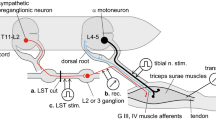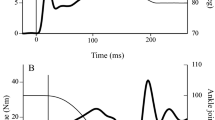Summary
To analyze the unloading reflex in humans we developed an experimental setup by which we could unload the muscle without any increase in tension, and could also vary the acceleration of the unloading independent of the pre-existing innervation level.
-
1.
Under static as well as under dynamic conditions, there regularly occurred a silent period with constant latency if during the shortening certain thresholds of shortening and acceleration were surpassed. This is interpreted as due to a decrease of spindle afferent discharge, and is compared with the temporal course of the phasic muscle stretch reflex.
-
2.
The unloading reflex is decreased or disappears completely if the mode of innervation of motor neurons during the initial baseline innervation is irregular and shows the tendency to synchronize. The role of the mode of innervation for the origin of the unloading reflex is discussed.
-
3.
The different behaviors of T reflex-excitability in complete relaxation, as well as the mode of innervation during contraction and silent period after passive shortening is discussed in regard to findings in de-afferentation (tabes), cerebellar ataxia and blocking of the vestibular nerve.
-
4.
In addition the unloading reflex has been explored at the m. soleus.
Zusammenfassung
Um den ER am Menschen zu analysieren, wurde eine Versuchsanordnung entwickelt, bei der ohne Spannungszuwachs der Muskel (Brachialis und Triceps) entlastet (entspannt), und die Beschleunigung der Entlastung unabhängig vom jeweiligen (augenblicklichen) Innervationsaufwand verändert werden konnte.
-
1.
Unter isometrischen wie unter dynamischen Bedingungen trat regelmäßig mit konstanter Latenz eine Innervationsstille auf, wenn bei der Verkürzung bestimmte Grenzwerte der Länge und der Beschleunigung überschritten wurden. Dies wird mit einer Abnahme der Spindelafferenzen interpretiert und verglichen mit dem zeitlichen Verlauf beim phasischen Dehnungsreflex.
-
2.
Der ER ist vermindert oder aufgehoben, wenn die Entladungsfolge der Motoneurone bei der initialen Halteinnervation unregelmäßig ist und Sychronisierungstendenz zeigt; die Rolle des Innervationsmodus für das Entstehen des ER wird diskutiert.
-
3.
Das unterschiedliche Verhalten von T-Reflexerregbarkeit bei völliger Entspannung, Innervationsmodus bei Innervation und Innervationstille nach passiver Verkürzung (ER) wird an Befunden bei Deafferentierung (z. B. Tabes), Kleinhirnataxie und Vestibularisblockade diskutiert.
-
4.
Zusätzlich wurde der ER auch am M. soleus untersucht.
Similar content being viewed by others
Literatur
Angel, R. W., Eppler, W., Iannone, A.: Silent period produced by unloading of muscle during voluntary contraction. J. Physiol. (Lond.)180, 864–870 (1964).
Hansen, K., Hoffmann, P.: Weitere Untersuchungen über die Bedeutung der Eigenreflexe für unsere Bewegungen. Z. Biol.75, 293–304 (1922).
—, Rech, W.: Beziehungen des Kleinhirns zu den Eigenreflexen. Dtsch. Z. Nervenheilk.87, 207–222 (1925).
Henneman, E., Somjen, G., Carpenter, D. O.: Functional significance of cell size in spinal motoneurons. J. Neurophysiol.28, 560–580 (1965).
Hofmann, W. W., Angel, R. W.: Transient responses of the normal and diseased motor system to sudden load changes. Neurology (Minneap.)17, 952–960 (1967).
Hufschmidt, H. J.: Über den Spannungsreflex beim Menschen. Z. Biol.111, 75–80 (1959).
Hufschmidt, H. J.: The demonstration of autogenetic inhibition and its significance in human voluntary movement. In: Muscular afferents and motor control, pp. 269–274. Stockholm: Almquist & Wiksell 1966.
—, Schaltenbrand, G.: Elektromyographische Analyse der sogenannten Areflexien. Dtsch. Z. Nervenheilk.179, 252–266 (1959).
Landau, W. M., Weaver, R. A., Hornbein, T. F.: Fusimotor nerve function in man: differential block studies in normal subjects and in spasticity and rigidity. Arch. Neurol. (Chic.)3, 10–23 (1960).
Sommer, J.: Der Entlastungsreflex des menschlichen Muskels. Dtsch. Z. Nervenheilk.150, 83–92 (1939).
Ristow, W., Struppler, A.: Labyrinthausschaltung und tonische Innervation. HNO (Berl.)189, 291–295 (1964).
Schwerin, O. v.: Untersuchungen über den Entlastungsreflex des Menschen. Dtsch. Z. Nervenheilk.14, 240 (1936).
Struppler, A., Jacobi, H., Jusic, A.: Der Entlastungsreflex des Menschen unter physiologischen und pathologischen Bedingungen. 8. Intern. Kongreß f. Neurologie Wien, 5.–10. 9. 1965.
Landau, W. M., Mehls, H. O.: Analyse des Entlastungsreflexes am Menschen. Pflügers Arch. ges. Physiol.279, 18 (1964).
Landau, W. M., Schenck, E.: Elektromyographische Studie zur Frühdiagnose der cerebellaren Ataxie. Kongreß f. Neurologie und Psychiatrie, Hamburg 21. 9. 1955; ref. in: Zbl. ges. Neurol. Psychiat.135, 227 (1956).
Struppler, A., Struppler, E.: Neurophysiologische Untersuchungen an deafferentierten Muskeln des Menschen. Z. Biol.11, 438–448 (1960).
Author information
Authors and Affiliations
Additional information
Herrn Professor Dr. Dr. G. Bodechtel zum 70. Geburtstag gewidmet.
Mit Unterstützung durch die Deutsche Forschungsgemeinschaft.
Rights and permissions
About this article
Cite this article
Struppler, A., Landau, W.M. & Mehls, O. Analyse des Entlastungsreflexes am Menschen. Pflugers Arch. 313, 155–167 (1969). https://doi.org/10.1007/BF00586244
Received:
Issue Date:
DOI: https://doi.org/10.1007/BF00586244




